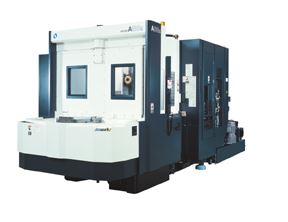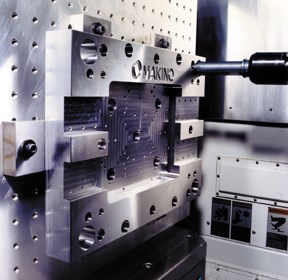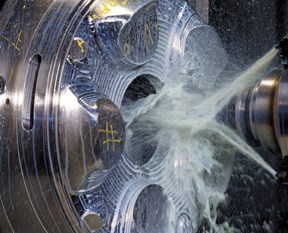The Argument for Horizontal Machining Centers
Although VMCs are widely used, HMCs offer more flexibility, versatility and a number of operations in one machine tool.
While most moldmakers use vertical machining centers (VMCs) on the shop floor to meet all of their machinery needs, a new trend is beginning to take shape. Horizontal machining centers (HMCs) are emerging as an alternative to their popular VMC counterparts because of their versatility, flexibility and automation - all resulting in reduced leadtimes.
According to Walter Stuermer, technical sales specialist for Mason, OH-based Makino, an EDM and CNC milling machine manufacturer, a moldmaker needs to look at the big picture - it's not all about machining time. "The key is to look at the overall process," he explains. "What you want to do is decrease the overall leadtime and many times the inhibiting factor is not necessarily the machining - it's the setup time, downtime and how many specialized tools that you must have."
Why Buy?
According to Stuermer, there's a growing trend toward industry professionals using HMCs across the board - for a number of reasons which are detailed below. Stuermer notes that in the past the industry has been very resistant to this technology because it's a different mindset.
"From the time this industry began, we've looked at things vertically and designed them vertically," Stuermer states. "We've generated toolpaths vertically, we want to put them on the machine vertically. All we have to do is rotate that 90 degrees so now - when we are looking at the part - instead of it laying on a table in front of us, it's on the wall in front of us. People are having trouble adjusting to this mindset - they don't understand the inherent advantages of the flexibility and accessibility. The setup procedure is outside the machine tool, you have no restrictions with the crane, and it's very easy to get to. It's the more progressive companies - the ones that are not only looking for solutions today, but also where they want to be in the next few years - that are looking at the horizontals."
Production Runs
"Those who concentrate on production applications are starting to use HMCs because you can load up the pallets on multiple sides and do a lot more machining and production runs in a shorter amount of time," Stuermer explains.
Forging Die Applications
Forging die makers have been exploring the opportunities with HMCs primarily because they do large numbers, Stuermer points out. "When you factor in the HMCs' ability for high-performance machining capabilities, i.e., hard milling, they were getting better quality parts," he comments. "The traditional way the forging people were doing things was to make full form electrodes and then EDM their cores and cavities. What this presents to the end part are some inherent character flaws - meaning that there will be a recast later from that type of process, which is very time-consuming because of the secondary operation needed in benching. No matter what, there will be microcracks in the part. So, if you go right to hard milling, you eliminate not only that HAZ layer - which is the heat-affected zone - but also the microcracking."
Blow Molding
Vacuum blow molders who typically work with aluminum molds - which can have high metal removal rates - also have started to use HMCs. "The advantages here are chip evacuation," Stuermer stresses. "You never want to recut those chips. You can use the laws of gravity, which makes it a lot easier to get rid of the chips."
Plastic Injection Molding
Increased global competition tops the list of why many plastic injection moldmakers are switching to HMCs. "Because of the fierceness of today's competition, moldmakers are looking for alternatives to the current ways that they are doing things," Stuermer explains. "They like the versatility, flexibility and automation that VMCs offer. Combine that with a machine tool that has the capability to do high-performance machining - which virtually eliminates the need for jig grinding or other grinding applications - and you've really taken a huge leap in technology.
"In effect, you are combining a reduction in leadtimes with a decrease in direct labor through the inherent characteristics of the HMC, meaning that it's as close to robotic automation that you are going to get without having a robot," Stuermer adds.
Additional Advantages
HMCs have the ability to take technology to the next level. "It's not just an HMC, it's the capabilities that it features," Stuermer says, "like the dramatic increase in technology that it offers for the end-user: roughing, gun drilling, hard milling and finishing operations. It's incorporating the same technology in the horizontal as there is in a vertical, but the horizontal has those inherent advantages of versatility, flexibility and automation."
Other advantages include accessibility to the workpiece or fixture while the machine is running. "With an HMC you have two pallets and several options," Stuermer says. "You can use any type of tombstone you want to mount the workpiece on, depending on what you are doing - four-sided, triangle shape, hexagon, octagon, etc. Combine that with the ability to load up those tombstones while the machine tool is still running with the other pallet, and you increase your spindle uptime. You can do the majority of your setup while it's still running. With a typical VMC, you have to do setup time when the machine is not running because you can't get in there otherwise - you only have one pallet to work with. With an HMC you have a virtually unlimited amount of sides."
Another factor to take into consideration is that HMCs have that built-in fourth axis, which allows you to rotate the part. "Now you can work on multiple sides of the workpiece; and if you have deep cavities you can rotate the part at a particular angle to get a larger, more rigid tool to reach in there," he explains. "You can go in with a tapered shank tool instead of a straight one, which adds a lot more rigidity to the cut. Also, you are able to utilize current technology as far as rpms and feedrate without worrying about chatter or tool deflection because of the strength of the cutting tool, since you are coming in on an angle."
Careful Consideration
Despite all of the advantages horizontal machining centers offer, it's not an investment to take lightly. "The investment is considerable and there are a lot of additional factors to consider," Stuermer states. "You need to have a much greater ATC (automatic tool changer). So now we're talking about not only the machine tool cost, but in order to run it effectively you also have to invest in the toolholders and all of the extra cutting tools. An HMC is not something that you are just going to come in off the street and buy.
"But, if you really do a cost analysis on it, you will see that with it you can have an increased spindle uptime anywhere from 60 to 90 percent, depending on the application," Stuermer continues. "That's a dramatic increase of the amount of time the machine is actually running and making money for the company." The bottom line is to weigh your options carefully and ensure that you have enough work coming in to justify the cost of the machine. The more you can accomplish with one machine tool, the better off you - and your business - will be.
Related Content
Machining Center Spindles: What You Need to Know
Why and how to research spindle technology before purchasing a machining center.
Read MoreMoldmakers Deserve a Total Production Solution
Stability, spindle speed and software are essential consideration for your moldmaking machine tool.
Read MoreSpeed, Productivity Gains and High Uptime Ease Decision for Second Five-Axis Machine
Byrne Tool + Design reduced setups and gained speed and productivity thanks to fast, accurate and compact five-axis CNC machining centers.
Read MoreControl Helps Push the Limits of Five-Axis Micro Mold Machining Accuracy
Toolmaker quickly meets the demands of critical medical device manufacturers with a new five-axis machine tool equipped with the right control technology.
Read MoreRead Next
How to Use Continuing Education to Remain Competitive in Moldmaking
Continued training helps moldmakers make tooling decisions and properly use the latest cutting tool to efficiently machine high-quality molds.
Read MoreAre You a Moldmaker Considering 3D Printing? Consider the 3D Printing Workshop at NPE2024
Presentations will cover 3D printing for mold tooling, material innovation, product development, bridge production and full-scale, high-volume additive manufacturing.
Read MoreReasons to Use Fiber Lasers for Mold Cleaning
Fiber lasers offer a simplicity, speed, control and portability, minimizing mold cleaning risks.
Read More




















.jpg;maxWidth=300;quality=90)



_300x250 4.png;maxWidth=300;quality=90)







